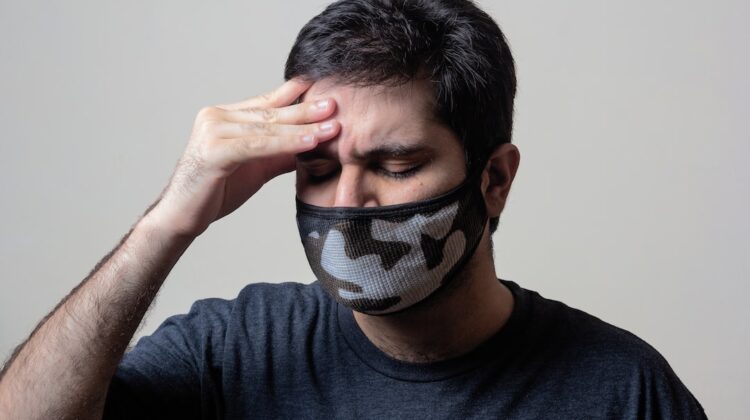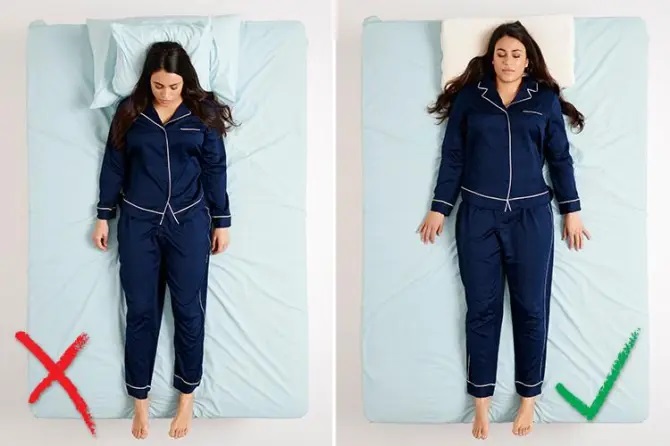
Do you often wake up with a headache and can’t figure out why? Many people don’t realize that the way they sleep can be causing tension headaches. How can bad sleep position cause headaches?
Poor sleep posture and sleeping for too long in one position can lead to pain or tension in the head and neck area. If you’re looking for ways to reduce your morning headaches, you probably should change the way you sleep.
In this article, we’ll explore how can bad sleep position cause headaches, how to improve it, and tips for maintaining good posture while sleeping.
Table of Contents
6 Most Common Types of Headaches
Before we go into how can bad sleep position cause headaches, first let us discuss the most common types of painful headaches.
Migraine Headaches
About 12% of Americans suffer from migraines.
Migraines are intense headaches that cause a throbbing or pulsing pain on one side of the head. They can last up to 72 hours and may be accompanied by nausea, vomiting, sensitivity to light and sound, blurred vision, and other symptoms.
Sinus Headaches
Sinus headaches occur when sinuses become inflamed due to allergies or a cold virus. Symptoms include facial pressure around the eyes and cheeks, nasal congestion with thick yellow discharge from the nose, headache in the forehead, feverishness, or feeling unwell with general malaise. Treatment includes decongestants for relief of symptoms as well as antibiotics if a bacterial infection is present.
Rebound Headaches
Rebound headaches are caused by taking too much medication for another type of headache such as migraine or tension-type headache over an extended period of time. The body becomes used to this medication, causing it not to work anymore. Rebound headache is where more medication is needed just for relief, which leads to a vicious cycle called “medication overuse syndrome” that needs medical attention immediately.
Cervicogenic Headache
Cervicogenic headaches originate in structures within your neck such as muscles, joints, and ligaments. Pain radiates up towards your head usually on one side only but can also affect both sides along with vertigo-like symptoms. These types of headaches often respond well to physical therapy treatments.
Hormone Headache
Hormonal changes during menstrual cycles can lead to hormonal headaches which are very similar to migraines but without any aura component. These headaches typically last from 1-3 days and then reappear when the next cycle begins. Treatment includes prescription medication and lifestyle modifications.
Exertional Headache
Exertional headaches appear after physical activity like running, swimming, and weight lifting. These types of activities increase blood flow throughout our bodies, leading to sharp pains behind our eyes and temples which from 5 minutes to 24 hours depending on severity level. Treatment includes rest, hydration, and ibuprofen taken prior to exercise.
How Can Bad Sleep Position Cause Headaches?
Chronic morning headaches from poor sleep position can be caused by a variety of factors. Pressure on the neck and shoulders, compression of blood vessels, and stress on the spine are all common triggers.
Pressure on the Neck and Shoulders
Sleeping in an uncomfortable or awkward position can cause tension to build up in your neck and shoulder muscles. This tension can lead to morning headaches as well as pain throughout other parts of your body such as your back or arms. To reduce this pressure and prevent tension headaches, try sleeping with a pillow that is supportive but not too thick so that you don’t strain any muscles while trying to get comfortable.
Compression of Blood Vessels
If you sleep in a position where there is excessive pressure placed on your head or neck, it can restrict blood flow which may result in morning headaches when you wake up. To avoid this issue, make sure that you are using pillows that support your head without putting too much weight onto any one area for extended periods of time.
If possible, try switching positions throughout the night so that no single area takes too much pressure for long periods of time.
Stress on the Spine
Sleeping with improper posture can place extra stress on our spine which may lead to early morning headaches. This is due to increased muscle tension around our necks and heads from being held in an unnatural position for prolonged periods during sleep.
To prevent this type of headache, it is important to ensure proper spinal alignment while sleeping by using supportive pillows and mattresses as well as avoiding twisting or bending too far in any direction while asleep.
How to Improve Your Sleep Position
Good posture while sleeping is essential for reducing morning headaches and other physical discomforts. It’s important to keep your neck in a neutral alignment, meaning that it should be neither bent too far forward nor pushed back too far.
Sleeping on your back is one of the best positions for reducing morning headaches from poor sleep position. When you lay flat on your back, it helps to keep your neck and spine in a neutral alignment, which reduces pressure points and helps prevent compression of blood vessels. It also allows for more even distribution of weight across the body.
To make this position more comfortable, use a pillow that supports both your head and neck while keeping them in line with each other.
Sleeping on your side is another good option for reducing early morning headaches. This position keeps your neck in a neutral alignment while providing support for the lower back by using pillows or blankets placed between the knees or behind the lower back.
Make sure not to twist or bend too far in any direction as this can cause further strain on muscles and joints leading to increased tension and discomfort.
If you prefer to sleep on your stomach, place a thin pillow underneath your abdomen so that there isn’t an excessive arching of the spine which could lead to pain later on.

(Source)
Can Pillows Cause Headaches?
Pillows are a key component of any good night’s sleep. They provide support and comfort, helping you to drift off into dreamland. But if your pillow isn’t the right size or shape for you, it could be causing more harm than good – like morning headaches.
It’s important to choose a pillow that suits your sleeping position. Side-sleepers need something firmer and higher than back-sleepers do while stomach sleepers should opt for something softer and flatter. If your head is not supported correctly when you lie down at night, this can cause tension in the neck muscles which may lead to morning headaches.
The material of your pillow also matters — memory foam pillows are great for providing support but they can become too hot during summer months as they don’t allow air circulation around the head area. Natural materials such as feather or down pillows tend to be cooler but they may not offer enough support if you’re a side sleeper with broad shoulders or a large frame.
Another factor to consider is how often you replace your pillows. Ideally, you should replace your pillows every one to two years as old ones will lose their shape over time and won’t give adequate support anymore — resulting in morning headaches.
Finally, make sure that whatever type of pillow works best for you fits properly within your bed setup. Having multiple layers of cushions under or above it might put extra strain on those same neck muscles, leading again to chronic headaches.
Conclusion
Can bad sleep position cause headaches?
It’s important to be aware of how your sleep position can affect your health. Poor sleep positions can cause morning headaches, so it’s important to take steps to improve your posture while sleeping.
Taking the time to adjust your mattress and pillows, maintain good posture during the day, and practice relaxation techniques before bedtime can help reduce headache pain from poor sleep position.
Remember that if you have any concerns about how bad sleep position might be causing chronic headaches or other health issues, talk with a healthcare professional for further advice.